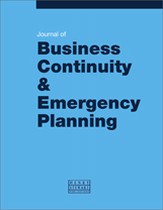Clinical guidelines for responding to chemical, biological, radiological, nuclear and trauma/burn mass casualty incidents: Quick reference guides for emergency department staff
Abstract
The word ‘DISASTER’ may be used as a mnemonic for listing the critical elements of emergency response. The National Disaster Life Support Education Foundation’s (NDLSEC) DISASTER paradigm emphasises out-of-hospital emergency response and includes the following elements: (1) detect; (2) incident command system; (3) security and safety; (4) assessment; (5) support; (6) triage and treatment; (7) evacuate; and (8) recovery. This paper describes how the DISASTER paradigm was used to create a series of clinical guidelines to assist the preparedness effort of hospitals for mitigating chemical, biological, radiological, nuclear incidents or explosive devices resulting in trauma/burn mass casualty incidents (MCIs) and their initial response to these events. Descriptive information was obtained from observations and records associated with this project. The information contributed by a group of subject matter experts in disaster medicine, at the Yale New Haven Health System Center for Emergency Preparedness and Disaster Response was used to author the clinical guidelines. Akin to the paradigm developed by the NDLSEC for conducting on-scene activities, the clinical guidelines use the letters in the word ‘disaster’ as a mnemonic for recalling the main elements required for mitigating MCIs in the hospital emergency department.
The full article is available to subscribers to the journal.
Author's Biography
Joseph Albanese received his PhD from McGill University, Department of Medicine, in 1998. Currently, Dr. Albanese serves as the Radiation Biodosimetrist for the Yale New Haven Health System Center for Emergency Preparedness and Disaster Response (YNHHS-CEPDR) and the State of Connecticut. Joseph is an experienced research investigator who holds an appointment at Yale University School of Medicine, Department of Therapeutic Radiology.
James Paturas is the Deputy Director for the Yale New Haven Center for Emergency Preparedness and Disaster Response, with over 30 years of experience in the healthcare industry. He is also Associate Director for the International Collaborating Center for Emergency Preparedness and Disaster Response. As the Director of Ambulatory Development and Emergency Medical Services for Bridgeport Hospital for over 20 years, he served as the chairman of the hospital’s emergency management committee. He is the Past President of the American College of Contingency Planners and Past President of the National Association of Emergency Medical Technicians. Mr Paturas currently serves on the editorial advisory boards of the Journal of Business Continuity & Emergency Planning and Inside Homeland Security. He is also a Certified Emergency Manager and Fellow of the American College of Contingency Planners.
Citation
Albanese, Joseph, Burich, David, Smith, Deborah, Hayes, Lynn, Paturas, James and Tomassoni, Anthony (2014, November 1). Clinical guidelines for responding to chemical, biological, radiological, nuclear and trauma/burn mass casualty incidents: Quick reference guides for emergency department staff. In the Journal of Business Continuity & Emergency Planning, Volume 8, Issue 2. https://doi.org/10.69554/YUNN6281.Publications LLP
